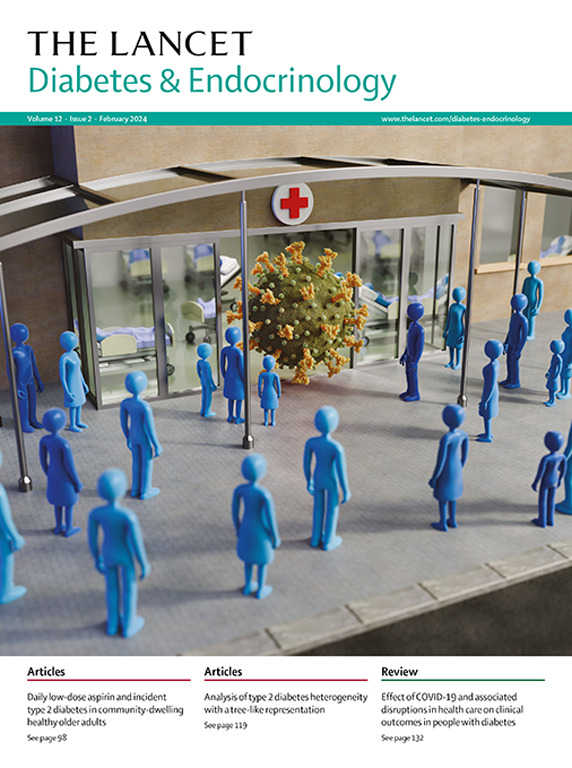1 型糖尿病患者单纯胰岛移植的长期疗效:意大利一项为期 20 年的单中心研究
IF 44
1区 医学
Q1 ENDOCRINOLOGY & METABOLISM
引用次数: 0
摘要
胰脏移植有可能通过恢复内源性胰岛素的产生来治愈1型糖尿病。然而,它的成功依赖于平衡改善血糖控制与免疫抑制治疗的风险。本研究旨在评估单独胰岛移植治疗1型糖尿病的长期结果,重点关注胰岛质量和免疫抑制方案对移植物存活和胰岛素独立性的影响,并权衡血糖控制益处和免疫抑制治疗的风险。方法本队列研究回顾性分析了意大利米兰Ospedale San Raffaele IRCCS单独接受门静脉内胰岛移植的18-67岁1型糖尿病患者。纳入标准包括55岁前诊断为1型糖尿病且伴有严重复发性低血糖或血糖不稳定的成年人。主要的排除标准包括HbA1c大于12.5%,BMI大于30 kg/m2,胰岛素需求超过每天1.2 IU/kg,以及免疫抑制治疗的禁忌症。参与者从医院的胰岛移植登记处招募。通过定期临床访问进行随访,回顾性收集数据。评估的结果包括患者生存、移植物生存、胰岛素独立性、血糖控制和不良事件。使用意向治疗法、混合效应模型、Kaplan-Meier估计、Cox和逻辑回归分析数据,以确定与代谢成功和风险降低相关的因素。结果:在2001年2月16日至2023年6月1日期间,79例患者单独接受肝内或门静脉内胰岛移植,共接受159次胰岛输注,平均总胰岛质量为9637胰岛当量(IEQ) / kg。并发症并不常见,主要涉及轻微出血,只有3%(79例中的2例)的患者需要手术干预。输注后血糖控制显著改善,HbA1c降低- 10.04 mmol/mol(- 13.63至- 6.46),每日胰岛素需求量降低- 13.35单位/天(- 17.04至- 9.65)。意向治疗分析显示,移植物的中位生存期(空腹C肽≥0.3 ng/mL)为3.9年(95% CI为1.6 ~ 6.2),44%(35/79)的胰岛素独立性中位为6年(95% CI为2.88 ~ 9.08)。接受超过10000 IEQ/kg的BAS、FK506和Rapa治疗的患者中位移植物生存期为9.7年(3.1 - 16.0),胰岛素独立性为73%(22人中有16人)。Kaplan-Meier估计1年生存率为86%,5年生存率为65%,10年生存率为47%,15年生存率为47%,20年生存率为40%。总生存率为92%(73 / 79),中位随访13.1年,20年生存率为84%。44%的患者(79名患者中的35名)报告了与免疫抑制治疗相关的不良事件,同种异体致敏率从基线时的6%增加到停药后的42%。这项对大型胰岛移植队列的分析为影响结果的因素提供了有价值的见解,并突出了潜在风险,支持知情的临床决策和未来β细胞替代策略的优化。本文章由计算机程序翻译,如有差异,请以英文原文为准。
Long-term outcomes of pancreatic islet transplantation alone in type 1 diabetes: a 20-year single-centre study in Italy
Background
Islet transplantation has the potential to cure type 1 diabetes by restoring endogenous insulin production. However, its success relies on balancing improved glycaemic control with the risks of immunosuppressive therapy. This study aimed to evaluate long-term outcomes of islet transplantation alone for type 1 diabetes, focusing on the effects of islet mass and immunosuppressive regimens on graft survival and insulin independence, and weighing glycaemic control benefits against the risks of immunosuppressive therapy.Methods
This cohort study retrospectively analysed individuals aged 18–67 years with type 1 diabetes who received intraportal islet transplantation alone at IRCCS Ospedale San Raffaele, Milan, Italy. Inclusion criteria comprised adults with type 1 diabetes diagnosed before the age of 55 years with severe recurrent hypoglycaemia or glycaemic instability. Major exclusion criteria included a HbA1c of more than 12·5%, a BMI of more than 30 kg/m2, and insulin requirements exceeding 1·2 IU/kg per day, along with contraindications to immunosuppressive therapy. Participants were recruited from the hospital's islet transplant registry. Follow-up was conducted through regular clinical visits, with data collected retrospectively. Outcomes assessed included patient survival, graft survival, insulin independence, glycaemic control, and adverse events. Data were analysed using an intention-to-treat method, mixed-effects models, Kaplan–Meier estimates, and Cox and logistic regression to identify factors linked to metabolic success and reduced risks.Findings
79 patients underwent intrahepatic or intraportal islet transplantation alone between Feb 16, 2001, and June 1, 2023, and received a total of 159 islet infusions, with a median total islet mass of 9637 islet equivalents (IEQ) per kg. Complications were infrequent and mostly involved minor bleeding, with only 3% (two of 79) of patients requiring surgical intervention. Glycaemic control improved significantly after infusion, with a reduction of HbA1c by –10·04 mmol/mol (–13·63 to –6·46), and a decrease in daily insulin requirements by –13·35 units per day (–17·04 to –9·65). The intention-to-treat analysis showed a median graft survival (fasting C peptide ≥0·3 ng/mL) of 3·9 years (95% CI 1·6 to 6·2) and 44% (35/79) insulin independence for a median of 6 years (95% CI 2·88 to 9·08). Patients receiving more than 10 000 IEQ/kg with BAS, FK506, and Rapa therapy had a median graft survival of 9·7 years (3·1–16·0) and 73% (16 of 22) insulin independence. Kaplan–Meier estimates indicated graft survival rates of 86% at 1 year, 65% at 5 years, 47% at 10 years, 47% at 15 years, and 40% at 20 years. Overall survival was 92% (73 of 79) over a median follow-up of 13·1 years, with a 20-year survival probability of 84%. Adverse events related to immunosuppressive therapy were reported in 44% (35 of 79) of patients, with allosensitisation rates increasing from 6% at baseline to 42% after therapy discontinuation.Interpretation
This analysis of a large islet transplantation alone cohort provides valuable insights into factors influencing outcomes and highlights potential risks, supporting informed clinical decision making and the optimisation of future β-cell replacement strategies.Funding
None.求助全文
通过发布文献求助,成功后即可免费获取论文全文。
去求助
来源期刊

The Lancet Diabetes & Endocrinology
ENDOCRINOLOGY & METABOLISM-
CiteScore
61.50
自引率
1.60%
发文量
371
期刊介绍:
The Lancet Diabetes & Endocrinology, an independent journal with a global perspective and strong clinical focus, features original clinical research, expert reviews, news, and opinion pieces in each monthly issue. Covering topics like diabetes, obesity, nutrition, and more, the journal provides insights into clinical advances and practice-changing research worldwide. It welcomes original research advocating change or shedding light on clinical practice, as well as informative reviews on related topics, especially those with global health importance and relevance to low-income and middle-income countries. The journal publishes various content types, including Articles, Reviews, Comments, Correspondence, Health Policy, and Personal Views, along with Series and Commissions aiming to drive positive change in clinical practice and health policy in diabetes and endocrinology.
 求助内容:
求助内容: 应助结果提醒方式:
应助结果提醒方式:


